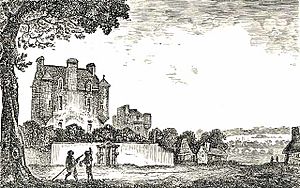Lauriston Castle facts for kids
Quick facts for kids Lauriston Castle |
|
|---|---|
| Edinburgh, Scotland NT2021676093 |
|

Lauriston Castle from the south
|
|
|
Location within the City of Edinburgh council area
|
|
| Coordinates | 55°58′16″N 3°16′42″W / 55.9711986°N 3.2784641°W |
| Type | L-plan tower house with a Jacobean range |
| Site information | |
| Owner | City of Edinburgh Council |
| Open to the public |
Yes |
| Site history | |
| Built | c. 1590 |
| Built by | probably Archibald Napier, 7th Laird of Merchiston |
| In use | 16th century to 21st century |
| Materials | Stone |
Lauriston Castle is a fascinating old building in Edinburgh, Scotland. It's a type of castle called a "tower house" that was first built in the 1500s. Later, in the 1800s, more parts were added to make it bigger.
This historic castle sits on Cramond Road South, looking out over the Firth of Forth. It's located between the areas of Cramond, Davidson's Mains, and Silverknowes. The large area around the castle, known as Lauriston Castle Gardens, is a public park that everyone can enjoy.
The castle was given to the city of Edinburgh a long time ago. Today, the City of Edinburgh Council takes care of it. It's also where the Lord Provost of Edinburgh (Edinburgh's civic leader) holds an annual garden party. Lauriston Castle is considered a very important historic building. Its beautiful gardens are also recognized as a special designed landscape in Scotland.
Contents
A Look Back: Lauriston Castle's Story
Early Days and Rebuilding
A castle stood on this spot even before the current one. However, it was almost completely destroyed in 1544. This happened during attacks on Edinburgh by troops led by the Earl of Hertford.
The tower house you see today was rebuilt around 1590. It was built by Sir Archibald Napier of Merchiston. He was the father of the famous mathematician John Napier. The castle was built for Archibald's first son from his second marriage, who was also named Archibald.
New Owners and Changes
In 1683, a wealthy Edinburgh goldsmith named William Law bought the estate. He was the father of John Law, who became a well-known economist. John Law inherited the castle, and it stayed in his family until 1823.
That year, a banker and mineralogist named Thomas Allan bought Lauriston Castle. In 1827, he hired a famous architect, William Burn, to add new parts to the house.
A famous writer, Sir Walter Scott, visited the castle on December 3, 1827. He wrote in his journal that Thomas Allan had shown "good taste" by adding to the old castle instead of tearing it down. He thought the new parts made it a very comfortable home.
Later owners included Andrew Lord Rutherfurd and Thomas Macknight Crawfurd.
A Gift to Scotland
In 1902, William Robert Reid bought Lauriston Castle. He owned a cabinet-making business in Edinburgh. When he passed away in 1926, he left the castle to Scotland. He wanted it to be kept exactly as it was.
Since then, the City of Edinburgh Council has managed the house. They make sure it stays preserved for everyone to enjoy.
What Does Lauriston Castle Look Like?
Castle Architecture
Lauriston Castle was originally a four-story tower house. It was built in an "L-plan" shape using stone. It had a round stair tower and two-story turrets at the corners. These turrets even had small openings for guns.
In 1827, the famous architect William Burn added a new section. This addition changed the castle into a larger country manor house.
Inside the Castle
Most of the inside of the castle looks like it did during the Edwardian period. This means it has furniture and decorations from the early 1900s.
Exploring the Beautiful Gardens
The large gardens at Lauriston Castle are open to the public. You can visit them for free! They have many different styles and types of gardens to explore.
The Japanese Friendship Garden
One special part of the gardens is the Japanese garden. It covers about one hectare (which is like two and a half acres). This garden was built by Takashi Sawano. It opened in August 2002 as a symbol of friendship between Edinburgh and the city of Kyoto in Japan.
See also
 In Spanish: Castillo de Lauriston para niños
In Spanish: Castillo de Lauriston para niños





